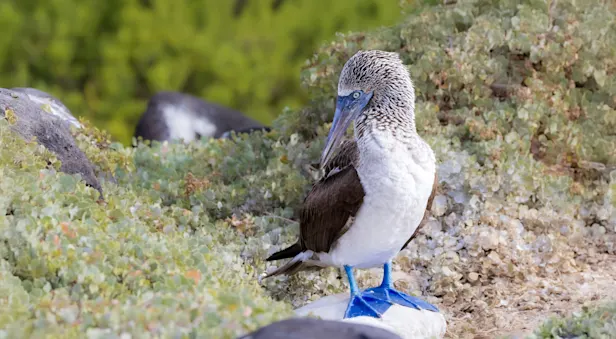
Know Before You Go


Waved Albatross Facts | Galapagos Wildlife Guide
One of the world’s most graceful birds is the magnificent waved albatross, which amazingly, can spend years at sea without ever touching land. In fact, it only comes to land to breed. It hardly flaps its wings, unless calm conditions warrant that.z
Physical Characteristics
It is the largest bird on the islands, averaging 3 feet in length with a wingspan of 8 feet
It may weigh up to 11 pounds
Long, narrow wings are stiff during flight
Long, hook-tipped bills
Short legs with large webbed feet
Range and Habitat
Apart from a few pairs that have bred on Isla de la Plata, off the Ecuadorian coast, the entire species inhabits the Galapagos, including a population of 50,000 to 70,000, with at least 20,000 breeding pairs that nest on Española Island. They nest on lava flows surrounded by boulders and sparse vegetation.
Behavior and Communication
All waved albatrosses are in flight between January and March when they are not breeding or incubating eggs.
Feeding Habits
They feed on squid, surface fish and crustaceans, usually on the ocean’s surface, far out to sea. On land, they scavenge on food that has been discarded by other creatures.
Breeding and Reproduction
Breeding occurs from March to January, and they nest on the ground. Parents feed their single chick for almost one year. Once the chick fledges, it will not return for four to five years.
Courtship typically occurs during the second half of the mating season. It can occur anytime while birds occupy the colony, but October is typically the most active month for mating. During one of the most remarkable ritualized mating displays performed by any bird, the waved albatross executes an impeccably arranged 20-minute mating “dance” that involves bowing, bill circling, swaying and freezing, honking, bill clicking and whistling.
Conservation
Waved albatross are susceptible to El Niño Southern Oscillations (ENSO) events, as this limits their food supply. They also tend to ingest plastic that floats on the ocean’s surface. And years with abundant mosquitoes cause them to abandon their nests. Their nesting grounds on Española Island are protected by the Galapagos National Park Service, and some feeding grounds are protected by the Galapagos Marine Reserve.
Header photo: Joseph Sina
See Waved Albatrosses on These Galapagos Adventures

Galapagos Discovery: The Nat Hab Experience
Small-group adventures aboard your choice of private yachts, led by our outstanding naturalist guides and photography pros. Snorkel and swim with sea lions, sea turtles and penguins on this incomparable nature odyssey.
































